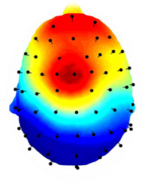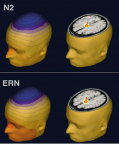Synthesis of most commonly studied ERPs
Generalities
An Event Related Potential (ERP) is a direct measure of the brain electrophysiological response to an exogenous (sensory inputs) stimulus or an endogenous (cognitive/motor) activity. Due to the weak signal to noise ratio (SNR), ERPs are only visible after averaging several stimuli or response-locked identical trials.
Nomenclature:
Most of the time, ERP waveforms are named according to their polarity (N for Negative and P for Positive) and the post-stimulus latency (in ms). Thus the N100 is a negative component of the ERP with maximal amplitude around 100 ms after the stimulus onset.
P50/P1
Mostly assessed via the auditory channel, the P50 is used to evaluate the sensory gating (i.e., the capacity of the brain to automatically filter unnecessary or redundant stimuli).
Scalp topography: Max at vertex, 50 ms post-stimulus onset. The paired-click paradigm consist in the presentation of a first auditory click followed by a second click 500 ms later. The sensory gating induces a reduction of the second P50 (Dolu et al., 2001). This reduction is altered in brain damaged or schizophrenic patients (Smith et al., 1994).
Generators: The auditory P50 generators are localized in the temporal lobes. Neural activity associated to the reduction of the second click-related P50 has been found in the frontal lobe suggesting a contribution of prefrontal processes in the sensory-gating (Korzyukov et al., 2007).
MisMatch Negativity (MMN)
The MisMatch Negativity is generated by the brain’s automatic response to any change in stimulation (Näätänen et al., 2007) according to subjective behavioral discrimination threshold. It corresponds to the ERP difference between a deviant and a standard stimulus between 100 and 200 ms after stimulus onset and can occur from all sensorial modalities. The oddball task, standard tone (80% of time) and a deviant one (20%) of a different frequency, is often used to investigate the MMN.
Scalp topography: maximum at frontal sites between 150-250 ms.
Generators: the auditory MMN has a supratemporal (pre-perceptual changes) and a right frontal (involuntary attention switch) sources. The MMN enables one to establish the brain processes underlying the initiation of attention switch to, conscious perception of, sound change in an unattended stimulus stream.
N100
The N100 is the electrophysiological signal of the stimulus processing at the perceptual level.
Scalp topography: occipito-temporal scalp topography with a maximum amplitude around 170 ms.
Generators: dorsal extrastriate cortex of the middle occipital gyrus and parietal lobe (Di Russo et al., 2002).
Scalp topography: fronto-central, maximum amplitude around 120 ms.
Generators: primary and associative auditory cortices, in the superior temporal gyrus and Heschl's gyrus (Zouridakis et al., 1998).
It has been proposed that the auditory N100 amplitude increases with the occurrence of low probability stimuli (Kramer et al., 1995). Reciprocally, the amplitude of the N100 initiated by a frequent sound decreases as the rate of presentation increases, which can be related to habituation mechanisms (Kramer et al., 1995; Moura et al., 2010). The auditory N100 amplitude is also known as an index of auditory-attention allocation (Hink et al., 1977).
P200
The P200 represents secondary (higher) perceptual processing of the stimuli. It has been found that both visual and auditory processing of higher level induce a P200. Although it is considered as an exogenous response because it is elicited even in absence of attentive manipulation, it is sensitive to attention allocation (Crowley and Colrain, 2004).
Scalp topography: fronto-central, maximum between 150 and 275 ms according to the modality and the experimental paradigm.
Generators: It is proposed, yet no consensus is still established, that the P200 originates from secondary sensorial cortices and parietal regions (Godey et al., 2001, for auditory processes).
N200
The N200 is the marker of the conflict monitoring and processing in terms of motor plan comparisons.
Scalp topography: fronto-central maximum around 200-220 ms.
Generators: mainly the dorsal anterior cingulate cortex (Folstein et al. 2008), but some studies have identified co-activation of the pre-supplementary motor area (pre-SMA) (Ullsperger & von Cramon, 2001) in conflict processing. In addition when averaged from response onset, the N200 is called the ERN (Error Related Negativity) that would be more associated to the ACC itself than to the pre-SMA.
This component is also declined under several subcomponent like the N2a, N2b, N2pc…
N270
It corresponds to the supramodal (i.e., independent of the stimulus modality) conflict processing (Zhang et al., 2013) in terms of selection of the relevant behavioral response.
Scalp topography: Fronto-central with a predominance in the left hemisphere, maximum amplitude precisely 270 ms post-stimulus onset.
Generators: few work suggest that the N270 originates from the right dorsolateral prefrontal cortex (Zhang et al., 2008).
The most common task is the Same Different Judgment (SDJ) task where a first stimulus S1 is compared to a second S2 (500ms latter). The mismatch between S1 and S2 elicits a strong N270. Simultaneous incongruent stimuli also elicit a N270 (Scannella et al., 2015). It has been proposed that the N270 is a downstream processing based on afferent dACC signal (N200 conflict monitoring) within a conflict processing network.
P300
The P300 component indexes brain activities underlying revision of the mental representation induced by incoming stimuli (Donchin, 1981). After initial sensory processing, an attention driven comparison process evaluates the representation of the previous event in working memory – a process distinct from, although related to, sensory stimulus feature mismatch detection (Heslenfeld, 2003; Kujala and Näätänen, 2003). The P3 is subdivided into the P3a and the P3b.
P3a
Scalp topography: fronto-central distribution, with a pic latency around 220-280 ms.
Elicited by both a distractor and a target: automatic/stimulus driven evaluation in an orienting reflex. For new stimuli and subjective to fast habituation mechanisms.
P3b
Scalp topography: centro-parietal distribution, with a pic latency around 310-380.
Elicited only by a target: The P3b is attention driven and its amplitude decreases as the attention deviates from the task.
Generators: it has been found that generators of the P3 may originitates from a large network including the prefrontal, the anterior cingulate and the parietal cortices.
N400
Studied for 30 years, it has been associated to meaning processing. And more generally to the semantic memory. Originally found during semantic incongruity, the N400 can be elicited by almost every aspect of language processing including words, drawings, photos, sounds and mathematical symbols (see Kutas and Federmeier, 2011 for an extensive revue).
Scalp topography: parieto-occipital with a maximum amplitude around 400 ms.
Generators: Spread from the posterior half of the left superior temporal gyrus (~250 ms) to the left temporal lobe (~365 ms) thereafter to the right temporal and frontal lobes (~370-500 ms).
P600/LPC
The Late Positive Component also called P600, is elicited in explicit recognition memory tasks. It is usually assessed by a new/old paradigm where participants are presented to a first list of items and they have to find them in a second list with new items. The LPC amplitude is larger for old compared to new items.
Scalp topography: parieto-occipital with a maximum amplitude around 600 ms.
Generators: lateral parietal cortex + contribution of medial temporal lobe and hippocampus.
Last edited: 03/04/2019








